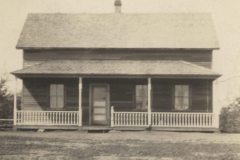Rationale
The building of prairie churches: The prairie provinces of Canada, starting in the late 19th century, became the area of the densest concentration of Ukrainians outside Ukraine. Ukrainians emigrating to Canada liked to settle near relatives and people they knew. Canadian government policies encouraged farming of the wide expanses of the prairies. The combination of these two factors and others (Martynowych, Lehr) meant that the prairies became dotted with Ukrainian churches. The iconic image of the prairie landscape is the open field dominated by a domed church and/or a grain elevator.
The abandonment and closing of prairies churches: Times changed and churches are now being lost at an alarming rate. Part of the problem is that Ukrainian communities, like others, are becoming less religious. People still love and treasure their churches, but they are no longer the focus of social and spiritual life, as they once were. Intermarriage with non-Ukrainians also plays a role.
Shifting demographics play an even more important role. The Ukrainian farmers of the prairies, or at least their children, are moving into cities, leaving the countryside depopulated.
The mechanization of farming encourages people to leave the farm and find work in the city. While, in the past, a large family was needed to work a quarter section, now one person can farm many hectares. Ron Adamko of Samburg, Saskatchewan, for example, 78 years old at the time of his interview, was able to run a many-hectare farm single-handedly, with his son coming in from a nearby city only on weekends. The increased sophistication of farming equipment has decreased the need for a large number of workers and allowed the children of Ukrainian farmers to move to the city.
The automobile has also encouraged demographic shifts. In the past, the farmer could not travel far to bring his produce to market or to shop for needed equipment and goods. Small towns all over the prairies would typically have a railway avenue. On it was the grain elevator where farmers left their grain to be picked up by trains. Small towns would have a restaurant where people could eat while taking care of their business. There would be a dry goods store and shops where equipment could be bought or repaired. With the ability to drive to a central hub, the small towns are shrinking. Meath Park is half boarded up. The John Deere dealership in Wroxton that supplied equipment to farmers and made its owner wealthy enough to build a very large and beautiful church has relocated to Yorkton, the closest city. Most buildings in Wroxton are abandoned and the huge church is closed.
The house where Doris Radesh, who later became Doris Kule, was born was first boarded and converted into a barn. This happened after the family bought a much larger farmstead near Vermillion. Doris’s brother Metro ran the farm, then sold it to the Soporvich family. The house was still standing in 2008 when it was photographed by Natalie Kononenko and Peter Holloway. It has since been torn down.
Shrinking congregations: The loss of rural dwellers means that churches which had somewhere around 150 members in the 1950s now have a dozen or less parishioners and, in many cases, these simply cannot afford maintenance costs, insurance, eparchy fees and other church expenses. The images below are photographs of old photographs of church congregations.
When churches close: Ideally, a church is closed with proper religious ritual. The building is de-sanctified in a special rite which transforms it from being a sacred structure back into something mundane. Such buildings can then be sold or repurposed, meaning they are used for activities other than religious services.
Many Orthodox churches are burned after de-sanctification and the ashes are buried, usually with the banya or cupola of the former church placed on top to mark the spot of burial.



